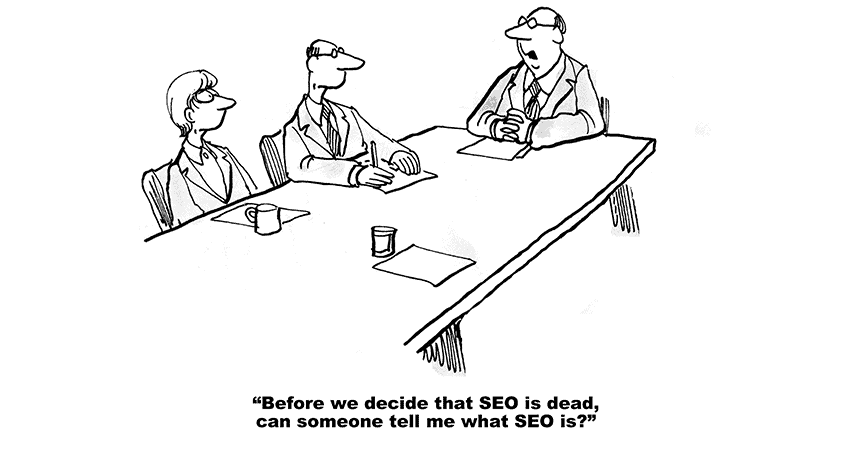SEO Is Dead. Long Live SEO!

SEO just ain’t what it used to be. In the Wild West days, I could post a press release on a dozen free sites, and if it had the right backlinks and anchor text, a high-volume keyword like Easter baskets would float to the top of Google search results. It was like voodoo magic.
Plus, I had product copy down to a formula. Take 200 words of copy (or more); insert the target keyword in the product name. Insert the keyword twice in the product description.
Add a keyword variation, a dash of SEO chutzpah, and voilà — the product had a chance to rank. Google didn’t seem to mind that the copy could be brutal.
Then Penguin and Panda came along and spoiled the fun. And Google’s Hummingbird update really lowered the hammer on keyword spamming and quick-fix SEO.
It was a low time for SEOs with limited resources (and imagination). Everywhere you heard the pronouncement: SEO is dead. Google had put the tricksters out of business. Why, then, do we still talk about SEO today?
Search Engine Optimization in 2022
Like the highly adaptable fruit fly, SEO has evolved. And today, with fierce competition for even modest keywords, SEO matters more than ever.
Not the cheap tricks that could vault a worthless page to position #1, but time-tested SEO principles like:
- Technical SEO (how a page is built)
- Site architecture (how a site is organized)
- Keyword research
- Useful information with a keyword theme
- Internal linking
- Citation building
- UX that impacts SEO (page load speed, user engagement, etc.)
Every website must have a solid SEO foundation. Otherwise, it won’t rank for much of anything. No rank, no traffic, unless you buy it.
So let’s pause to revisit some SEO schemes of the past, review today’s best practices, and figure out what you or your marketing firm might be doing wrong.
Dead: Keyword Spamming & Stuffing
Are you still pasting every possible keyword permutation into the meta keyword field of your HTML editor? Google stopped looking at meta keywords over 20 years ago.
Likewise, keywords crammed on a page won’t give you a lift and may even hurt you in the age of artificial intelligence, semantic search, and natural language.
Google and other search bots now process a page with near-human intelligence. What sounds good to the ear also sounds good to the search bots.
Alive Today
Keyword research is the cornerstone of all organic SEO. All content should have a keyword theme or idea; the more focused and relevant you make it, the better its chances of ranking. Focus. Relevance. Search intent.
You could write the greatest-ever gender reveal party idea for your plumbing site. Will it rank for a coveted baby shower keyword? Of course not, because it’s irrelevant to your business, and you have no proven expertise in gender reveal parties.
Or you could post a fabulous piece about bathtub installation, but if Google decides that the best result for the search is a video (search intent), your 2,000-word blog won’t outrank it.
Understand your audience and what they’re looking for. Answer their questions clearly and thoroughly. Write about the things you know, and the traffic will follow.
Dead: Keyword Density
Years ago, when it was known as SEOMoz, MOZ had a free tool to analyze on-page SEO. One metric was keyword density or the ratio of a target keyword to other words on a page.
If density was on the low side, you could shoehorn a few keywords into the copy to give the page a lift. Keyword density was closely related to keyword spamming because, in both cases, you ended up with undigestible copy that only a search engine could love.
But it worked. It no longer does. As noted, Google understands context and search intent and reads copy almost like a human being.
Alive Today
Don’t abandon your keyword lists. They should serve as a guide for your content initiatives. Organize your content in keyword themes.
But if your copy reads like keyword spam, it is keyword spam. Google won’t reward it. Write for human beings. Keep your copy focused.
- Short paragraphs
- Plenty of white space
- Bullets and numbered lists
- Descriptive headings
Search engines love headings almost as much as humans, who scan most web pages, pausing on sections of particular interest.
Dead: Black Hat Link Building
Backlinks are links from other sites to your website. In the old days, a few backlinks from sites with high domain authority could help you dominate the search results.
“Black hat” link builders would purchase these links rather than earning them, or use submission software to create thousands of low-value links from spam sites and link farms.
Like the “happy times” of the U-boats, it was bound to end. Beginning in 2012, Google rolled out algorithm updates to identify backlink spam and punish the abusers.
Nowadays, Google mostly ignores spammy backlinks. So if you’re still building links from crummy sites, you’re wasting your time. Unless it’s your hobby.
Alive Today
Citation building continues to be one of the best ways to create backlinks. “Citations” are mentions of your business on valuable sites and directories (like Angi or Yellow Pages), with or without a link.
Google’s local search algorithm relies heavily on citations to evaluate businesses and rank them in the “snack pack” or the top three map results.
Link-baiting is another effective and legitimate approach. Here, you provide valuable content on your site (like a blog) that naturally attracts backlinks and shares.
Finally, frequent posts on your Google Business Profile, Facebook page, Yelp profile, etc., with links to your site, will boost your online visibility and backlink profile.
Dead: SEO “Content” Written for Search Engines
We’ve already touched on this point, but it’s worth saying again: write for people, not search engines. If your content has no real value, no real audience, and isn’t truly helpful, Google may not even index it, let alone rank it.
Alive Today
Search-optimized content is the #1 source of organic traffic to most local business websites. Most content-poor sites drive almost no traffic.
Who should develop the content? Someone who knows something about the subject. You can give it a shot, but if you run a small business:
- You may not have time to write
- You may not be comfortable with your writing skills
- You may not know what to write about
Most business owners outsource their content development. But not every freelance writer understands SEO, and not every SEO specialist can write for humans!
Do your research and work with a quality agency. The best approach is to start small: commit to one blog post per month, then increase the frequency as you begin to see results.
Dead: SEO Guest Posting & Blog Network Spam
Guest posting is when you write an article for another site in your industry to earn a link back to your site. Blog networks are sites that host articles from multiple authors to build links and traffic. These tactics were popular a few years ago but are no longer effective.
Alive Today
Google’s Penguin algorithm targets low-quality link spam. Guest posting still has value on high-quality sites with good domain authority as long as the post is original and isn’t published anywhere else online.
Dead: Doorway Pages & Link Wheels
A doorway page is a low-quality, spammy page created solely for ranking in Google. These pages are stuffed with keyword-rich content and usually offer little useful information.
A link wheel is the result of a tactic where you create multiple doorway pages and link them together in a “wheel” pattern. So Page A links to Page B, Page B links to Page C, and so on.
Both methods are considered black hat SEO and will likely result in a penalty from Google if you’re caught using them.
Alive Today
For pages to rank well, make sure they’re thorough, well-formatted, well-linked internally, and valuable to your visitors. Stuffing them full of keywords will only hurt your chances of ranking.
Dead: SEO & Social Media Are Separate Channels
It used to be common for businesses to treat SEO and social media as separate channels. But today, they’re more intertwined than ever.
Alive Today
Social signals (shares, likes, etc.) are a ranking factor in Google’s algorithm. So if you want your website to rank higher, you need to be active on the wider internet. It’s called offsite SEO, and your agency may be able to guide and focus your efforts.
Dead: 40% Clickthrough on Position 1
Years ago, a leaked AOL document revealed that the #1 organic position in a search result got 40% of all clicks among AOL users.
Much has changed since. Search results are more crowded than ever, and the #1 organic result can appear well below the fold. I’ve seen keywords in the top position (verified in the Google Search Console) have a click-through rate of 2% or less.
Alive Today
More crucial than rank for a pet keyword is the total organic traffic a web page generates. Some of that traffic will come from long-tail keywords you never targeted, expected, or even knew existed.
The trick is to write helpful, information-rich copy around a core keyword (for which you may never rank). As long as you do, the traffic will come, and when it does, you can always revisit the original copy, tweak it, and get even better results.
Dead: SEO Hucksters & Snake Oil Salesmen
Unfortunately, the SEO industry is fraught with charlatans who promise to get you to the top of Google overnight. They often use black hat SEO tactics that can result in a Google penalty. If someone makes a guarantee like this, run the other way!
Alive Today
The only thing any good SEO can promise is more traffic from organic searches. Some agencies won’t guarantee even that.
Ask your agency for case studies and anonymized analytics from past and present SEO campaigns. The best you can do is work with an experienced, reputable agency that uses white hat tactics and has a track record of success.
About Culture Cube Marketing
Culture Cube is an Upland, CA-based digital marketing agency. Our services include small business SEO, local SEO, content development, website design, and other digital services.
We create custom databases, tie e-commerce to inbound marketing and automation, and integrate PR, social media, and SEO in all aspects of marketing.
Above all, we build websites with clear messaging, architecture, navigation, and value propositions to cast our clients in the most positive light.

Peter Losh is the SEO Director of Culture Cube Marketing in Upland, California. He's also a de facto UX designer, site builder, and content creator. Unlike most folks in the SEO biz, he works directly on the sites he optimizes, having witnessed the effects of recommendations that go ignored or misunderstood (in previous gigs).
Peter has worked on websites since the salad days of the internet, first as a graphic artist and web designer at the Centers for Disease Control. Then came several years of freelance web development, SEO and e-commerce management for business sites of various sizes, and ultimately a 10-year stint as the sole SEO Manager of PartyCity.com.
In his spare time, he enjoys classic film, classical music, and classic comebacks. And cats.
Professional Work Experience
- Search engine optimization
- Ecommerce management
- Conversion rate optimization
- UX design and analysis
- Copywriting and training
- E-mail campaign design
- Web design and development
- Graphic design



